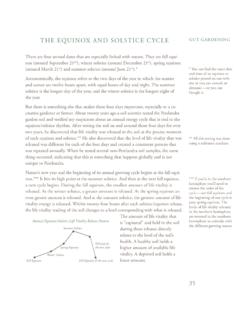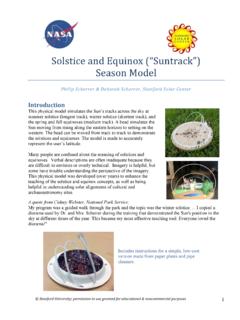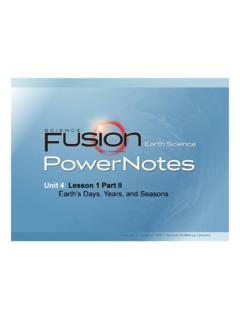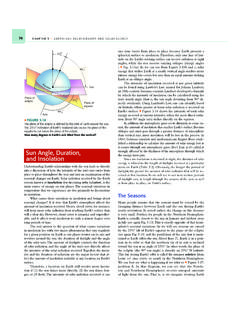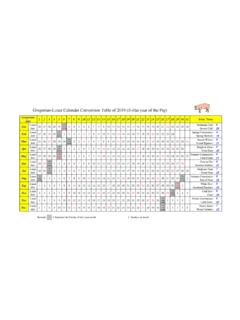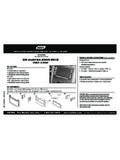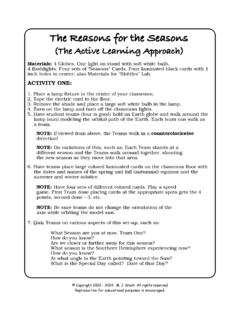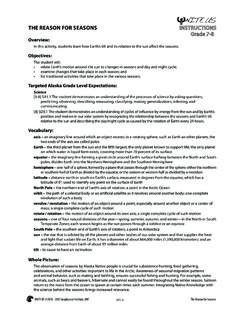Transcription of The Tilt of the Earth and the Seasons - VDOE
1 Science Enhanced Scope and Sequence Grade 6. The Tilt of the Earth and the Seasons Strand Interrelationships in Earth /Space Systems Topic Investigating the relationship of Earth 's tilt and the Seasons Primary SOL The student will investigate and understand the organization of the solar system and the interactions among the various bodies that comprise it. Key concepts include g) the relationship of Earth 's tilt and the Seasons . Related SOL The student will demonstrate an understanding of scientific reasoning, logic, and the nature of science by planning and conducting investigations in which i) models and simulations are designed and used to illustrate and explain phenomena and systems. Background Information Imagine a line running through the Earth from the South Pole to the North Pole. As the Earth rotates, that line always points to Polaris, the North Star. For this reason, the Earth 's axis tilts about off of a 90 angle with respect to the plane of the flat orbit it makes around the sun.
2 On the first day of summer, the sun is above the horizon for the maximum number of hours and reaches its highest point in the sky at noon. The angle at which light rays from the sun hit the Earth affects the temperature on Earth , the more direct the rays are, the more light and heat are absorbed and the higher the temperature becomes. In summer, when the sun is high in the sky at noon, its rays strike Earth almost perpendicular to the surface because light travels in straight lines. As the Earth revolves around the sun, parts of the Earth get hit with rays directly (at nearly a 90 angle), and parts are hit with rays indirectly (at more oblique angles). The Seasons in any given region of the Earth are a consequence of the directness of the rays and the length of days in that region. In winter when the sun is low in the sky at noon, its rays hit the Earth indirectly at a more oblique angle, and the light and heat are more dispersed, or spread out. Also, the days are shorter, allowing for less heating to occur.
3 In summer, not only are the rays more direct, resulting in more intense light and heat, but there are more hours of light in the day, so the land, sea, and air have more time to absorb the light and heat. Summer and winter solstices: The sun rises and sets in different spots throughout the year. In the Northern Hemisphere, the sun rises at its most southerly point in midwinter. This event is known as the winter solstice and occurs on December 21. The sun rises at its most northerly point in midsummer, an event known as the summer solstice, which occurs on June 21. Spring and fall equinoxes: There are two days in the year when every place on Earth experiences a 12-hour day , the length of the day and the night are equal. These special days occur midway between the solstices. The sun rises due east and sets due west on the spring (vernal) equinox (around March 21) and the autumnal equinox (around September 22). The word equinox, derived from Latin, means equal night.
4 Very little change occurs in sunrise and sunset times in the weeks before and after the solstices. In the weeks around the equinoxes, the sunrise- and sunset-time changes and the sun-position changes are considerable. virginia department of education 2012 1. Science Enhanced Scope and Sequence Grade 6. Here are some common misconceptions: Seasons occur because the Earth moves in an orbit that is closer to the sun in the summer and farther away from the sun in winter. In fact, Earth travels in a relatively circular orbit around the sun, staying about 150 million kilometers from it throughout the year. Many textbooks illustrate the solar system from an angle rather than from a point of view that is directly above so that the Earth 's orbit looks more like an ellipse rather than almost a circle, as it should. Nearly all the planets revolve in circular, not elliptical, orbits about the sun. Seasons occur because of the tilt, which makes the Northern Hemisphere closer to the sun during its summer.
5 In fact, the Earth is closest to the sun around January 3 and farthest from the sun about July 5; therefore, the slight change of distance from the sun due to Earth 's slightly noncircular orbit has nothing to do with the Seasons . The hemisphere that is tilted toward the sun will experience summer (true) because it is closer to the sun (false). Actually, the Earth is so much smaller than the sun and so far away from it that the difference in distance from the sun to each of the two hemispheres at a given time is negligible. Again, the Seasons are dependent on the angle of the sun's rays and the length of the days, not on the distance of the Earth from the sun. Understanding Seasons is difficult for many people, so you should not expect all students to gain a complete understanding from this lesson. Materials Globe Lamp without shade Light bulb (preferably clear). Styrofoam balls Dowels or knitting needles Rubber bands Pushpins Vocabulary axis, direct, dispersed, equinox, hemisphere, indirect, orbit, solstice Student/Teacher Actions (what students and teachers should be doing to facilitate learning).
6 Introduction 1. Inform students that astronomers long ago discovered the reason the sun looks like it is taking a different path through the sky in different Seasons of the year. They found that the Earth 's axis tilts an angle that is less than a 90 angle with respect to the plane of the flat orbit it makes around the sun. The reason for this tilt is that the North Pole end of the Earth 's axis always points to Polaris, the North Star. (These statements may be hard for students to visualize and understand without a graphic demonstration, which is provided in the demonstration exercise describe under Procedure below.). 2. You may wish to do the following demonstration before (or instead of) having the students undertake the Procedure. Place a small representation of Polaris somewhere high up in the virginia department of education 2012 2. Science Enhanced Scope and Sequence Grade 6. room. Tell students that the globe represents Earth , the floor represents the plane of Earth 's flat orbit around the sun, and the bare bulb elevated in the center of the room represents the sun.
7 3. Turn on the bare bulb (the sun), hold up the globe (the Earth ) at the same level as the bulb, and tilt the globe on an angle to the floor (its orbit) so that the North Pole points to Polaris. Revolve the Earth around the sun, being careful to keep the North Pole pointing to Polaris at all times. Have students notice how the sun's light falls on the Earth in the various Seasons of the year. Make sure they really see that as the Earth revolves around the sun, the North Pole is pointed toward the sun in the Northern Hemisphere's summer (pause and demonstrate) and away from the sun in the Northern Hemisphere's winter (pause and demonstrate). You might attach a small toy figure onto the globe at your location and point out why this person in your spot on Earth will see the noon sun higher in the sky in the summer and lower in winter. Procedure 1. Give each student a Styrofoam ball (representing the Earth ) with a knitting needle or dowel stuck through it (representing its axis) and a rubber band around the middle (representing the equator).
8 Also, give each student a pushpin to represent a person. Point out the North Star, Polaris, placed high up in the room. 2. Ask, Where is the North Pole? Where is the equator? Tell students to put their pin- person somewhere in the Northern Hemisphere to represent a person in virginia . 3. Have each student slowly orbit his/her Earth around the sun (bare light bulb in center of room), carefully keeping the axis pointing to Polaris at all times until the North Pole is pointing toward the sun. At that point, have students stop orbiting and rotate their Earths on the axes so that it is noon for the pin persons. Ask, To the pin person, would the sun look high or low in the sky? What season is it for the pin person, who is located in the Northern Hemisphere? What season is it in the Southern Hemisphere? . 4. Have each student continue to orbit his/her Earth , keeping the axis pointing to Polaris as always until the North Pole is pointing away from the sun. Again, have students stop orbiting and rotate their Earths so the pin persons are in the noon-day sun.
9 Ask the same questions as before. Also, ask what is the difference in the length of the pin's shadow at noon in the winter and summer. (The shadow is longer in winter than in summer.) Ask whether they can see why winter days are shorter than summer days even though the Earth rotates on its axis at a constant speed at all times. (With the Northern Hemisphere tilted away from the sun, the northern regions experience a lower sun arcing a shorter distance across the sky , a shorter day.). 5. Now, have students orbit their Earths to the spring equinox and/or the fall equinox positions, reminding them that only on these two days are the lengths of the day and night equal. Have them observe that the Earth is now in the part of its orbit where the North Pole points neither toward nor away from the sun. The sun's rays strike the Earth directly over the equator; therefore, in both hemispheres, there is no extreme sun height during these times of year. Ask, What could the word equinox mean?
10 (Equal night and day). How many hours of day and how many of night would that be? (12 and 12). virginia department of education 2012 3. Science Enhanced Scope and Sequence Grade 6. Assessment Questions o What is the difference between direct and indirect rays of the sun? What is their effect on Seasons ? o How can you predict the season of the northern hemisphere based on the Earth 's tilt? Journal/Writing Prompts o Draw a representation of the Earth 's revolution around the sun. o Explain why the Seasons are caused not by the distance of the Earth from the sun changing, but by the tilt of the Earth 's axis and the resulting indirect or direct rays of the sun. o Predict the differences in animal migration, weather, ocean temperature and currents, and other Earth systems if the Earth 's axis were not at an angle but were at 90 with respect to the plane of the flat orbit it makes around the sun. Use drawings and written descriptions to support your predictions.










